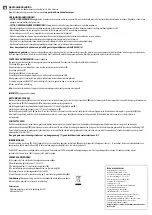
Power Jack Closeup
Take your right-angle male headers, and snap of a section of three
headers. Solder the 3-pin header to the three pads on the end the board,
and plug the servo into the the header. Be careful to get the plug oriented
correctly – you can check the color code table in the servo tutorial, or
consult the servo manufacturer’s datasheet.
Solder the switch wires to the
IN
and
GND
pads on the Servo Trigger and
the power pigtail to the
VCC
and
GND
pads on the edge of the board.
These are mirrored on opposite edges of the board – they’re wired in
parallel, so you can use either set of pads. The red wire should connect to
the
VCC
pad and the black to
GND
.
Before we power up, take a moment to double-check your work against the
photo below (click on the picture for a larger version). In particular, make
sure that the power and servo connections are oriented correctly.
Adjusting the trimpots.
Adjust the trimpots on the back of the board. Set
A
fully counterclockwise,
B
fully clockwise, and set
T
to the middle.
Finally, apply power. The servo should start to turn. If not, power down, and
recheck your work.
While it’s running, tap the switch. The servo will take a couple of seconds to
slow down, stop, then reverse. Tap the switch again, and it will go back to
the original direction.
Now you can adjust the trimpots to configure the servo.
•
A
sets the speed and direction of the motor before the switch is
actuated.
•
B
sets the speed and direction of the motor after the switch is
actuated.
•
T
sets the time it takes to get from A to B and back.
When A and B are near the middle of their rotation, the servo will stop.
Turning them clockwise from there instructs the servo to turn in one
direction; turning them counterclockwise results in the opposite direction.
The farther from the center, the faster the servo turns. The transition time is
adjustable between 50 milliseconds and 10 seconds. The transition time is
constant – when set to 2 seconds, the servo will take 2 seconds to move
between A and B, regardless of how close the A and B settings are.
In the next section, we’ll explore some of the finer details of the Continuous
Rotation Servo Trigger.
Theory Of Operations
Page 5 of 13































